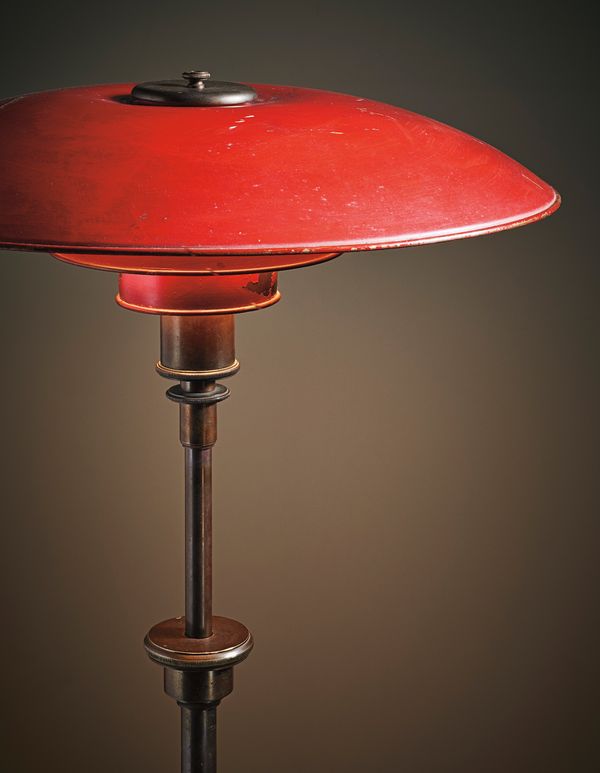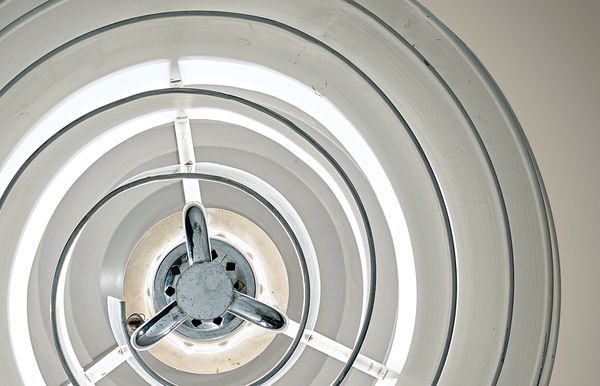Poul Henningsen Pair of early and rare large ceiling lights, type 5/5 shades
Poul Henningsen and his manufacturer Louis Poulsen applied under Danish law on 4 December 1925 for the patent titled 'Reflector for Incandescent Lamp', which was granted on 19 May 1928 with the Danish patent number 38897 and then by the USA patent office on 6 May 1930.
The specifics of the patent included a technical drawing and stated the characteristics of the invention as follows: "A reflector for difusing the light of incandescent lamps comprising a plurality of concentric downwardly concave shades disposed above and below the plane of the source of light, the inner surfaces of said shades being directed toward the source of light, the surfaces of said shades making at all points angles less than 45 with a line to the source of light, the inner surfaces of the shades being dulled." Regarding Henningsen's reliance upon patent law and copyright law, Stina Teilmann-Lock writes "the lamp has been defined, respectively, as both 'industrial property' and 'artistic property'; as an invention and as a work of art."
The lamp has been defined as both...an invention and a work of art.

Poul Henningsen Early adjustable standard lamp, type 5/3 shades (detail)
Prior to the patent being granted, Henningsen was awarded by the jury of the 1925 World's Fair in Paris, L'Exposition Internationale des Arts Décoratifs et Industriels Modernes, a gold medal, and Louis Poulsen silver for their lighting. Presented at the exposition was the 'Paris' ceiling light (lot 31), which can be considered the progenitor for the "system of lamp shades that completely surround the source of light so that no radiating rays can meet the eye directly." Henningsen developed his 'system of shades' into types, which ranged from smallest to largest, and were available in different types of glass and painted copper. The shades were then applied to various lighting formats, including: the Standard lamp (lot 10); the exquisite and elegantly designed 'Piano' lamp (lot 19); the 'Academy' chandelier (lot 49); and the Early table lamp (lot 50).

Poul Henningsen 'Spiral' ceiling light (detail)
Henningsen's designs were also used in many prestigious interiors including ceiling lights for the 'Villa Tugendhat' designed by Ludwig Mies van der Rohe. However, there were 'system of shades', such as the Pair of early and rare ceiling lights (lot 28), produced in opaque glass with a painted gold rim, that outshone others. Henningsen's design process developed further and he discussed the 'Spiral' ceiling light (lot 13), designed for the University of Aarhus, in LP Nyt, a Louis Poulsen publication. In the article, he states "The principle in this lamp is much the same as in the PH-lamp and the Globe per se, but the light ray direction is reminiscent of the way it shines outwards from the Globe. The shape is geometric and the light strikes all the parts of the spiral which are illuminated at the same angle reflecting it out into the room in the same way."

Poul Henningsen 'Spiral' ceiling light (detail)
More than ninety years after Paris' L'Exposition Internationale des Arts Décoratifs et Industriels Modernes, Henningsen's work still resonates, and the "PH lamp" continues to be "an exceedingly beautiful light." The Henningsen lights on offer in our upcoming Nordic Masters auction are from a curated collection of early important pieces, all of which are exceptional in age, scale, condition and provenance.
